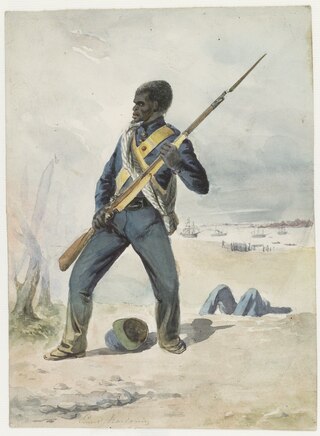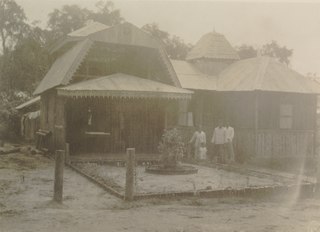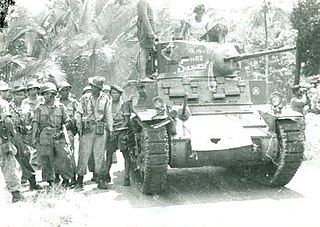Related Research Articles

South Maluku, also South Moluccas, officially the Republic of South Maluku, is an unrecognised secessionist republic that originally claimed the islands of Ambon, Buru, and Seram, which currently make up the Indonesian province of Maluku.

The Royal Netherlands East Indies Army was the military force maintained by the Kingdom of the Netherlands in its colony of the Dutch East Indies, in areas that are now part of Indonesia. The KNIL's air arm was the Royal Netherlands East Indies Army Air Force. Elements of the Royal Netherlands Navy and Government Navy were also stationed in the Netherlands East Indies.

The Empire of Japan occupied the Dutch East Indies during World War II from March 1942 until after the end of the war in September 1945. It was one of the most crucial and important periods in modern Indonesian history.

The Royal Netherlands East Indies Army Air Force was the air arm of the Royal Netherlands East Indies Army in the Dutch East Indies from 1939 until 1950. It was an entirely separate organisation from the Royal Netherlands Air Force.
Tanah Merah is a town in the South Papua province of Indonesia on the bank of Digul River, located some two hundred miles from Merauke within the interior of Western New Guinea. It is the administrative center of Boven Digoel Regency; administratively, it is covered by the Persatuan kampung of Mandobo District.

Boven Digoel Regency is an inland regency (kabupaten) in the northeastern part of the Indonesian province of South Papua. It was split off from Merauke Regency on 12 November 2002. It is bordered to the south by the residual Merauke Regency, to the west by Mappi Regency, and to the north by the province of Highland Papua. At the same time, to the east lies the international border with Papua New Guinea.

The Dutch East Indies, also known as the Netherlands East Indies, was a Dutch colony with territory mostly comprising the modern state of Indonesia, which declared independence on 17 August 1945. Following the Indonesian War of Independence, Indonesia and the Netherlands made peace in 1949. In the Anglo-Dutch Treaty of 1824, the Dutch ceded the governorate of Dutch Malacca to Britain, leading to its eventual incorporation into Malacca (state) of modern Malaysia.

Belanda Hitam was an Indonesian language term used to refer to Black soldiers recruited by the Dutch colonial empire for service in the Royal Netherlands East Indies Army (KNIL), the colonial army of the Dutch East Indies. The recruitment of Black soldiers into the KNIL resulted from a combination of factors, including the heavy losses suffered by Dutch forces in the Java War and concerns over the reliability of indigenous KNIL troops. Between 1831 and 1872, over 3,000 West Africans, mostly Akan people, were recruited from the Dutch Gold Coast for KNIL service in the East Indies.

Boven-Digoel was a Dutch concentration camp for political prisoners operated in the Dutch East Indies from 1927 to 1947. It was located in a remote area on the banks of the river Digul, in what is now Boven Digoel Regency in South Papua, Indonesia. The site was chosen in 1928 for the internal exile of Indonesians implicated in the 1926 and 1927 communist uprisings in Java and Sumatra. Indonesian nationalists not associated with the Indonesian Communist Party were subsequently also sent there.

The Netherlands Indies Civil Administration was a semi-military organisation, established in April 1944, tasked with the restoration of civil administration and law of Dutch colonial rule after the capitulation of the Japanese occupational forces in the Dutch East Indies at the end of World War II.

Major TNI Marthen Indey (1912–1986) was a colonial police officer in New Guinea, Dutch East Indies who later became nationalist fighter in the Indonesian National Revolution and a supporter of Papua becoming part of Indonesia. He was declared a National Hero of Indonesia in 1993 along with two other people of Papuan descent, Frans Kaisiepo and Silas Papare.
Rupert Ernest Lockwood was an Australian journalist and communist activist.
The Battle of Margarana was a battle fought between the Netherlands Indies Civil Administration (NICA) and the recently created, rebelling Ciung Wanara Battalion that occurred in Marga, in Bali Indonesia.

The Invasion of Ambon was a combined Indonesian military operation which aimed to seize and annex the self proclaimed Republic of South Maluku.

The 1st Infantry Battalion of the Royal Netherlands East Indies Army was a Dutch colonial military unit that was active in the Dutch East Indies during World War II and the Indonesian National Revolution.
The Van Mook–MacArthur Civil Affairs Agreement was an agreement between the United States and the Dutch government-in-exile. It concerned the jurisdiction over and administration of civil affairs in Dutch East Indies territory liberated by an Allied expeditionary force during WWII.

Louis Johan Alexander Schoonheyt (1903-1986), commonly known as L. J. A. Schoonheyt, was a Dutch medical doctor, writer, and supporter of the National Socialist Movement in the Netherlands before World War II. From 1935 to 1936 he was the camp doctor at the Boven-Digoel concentration camp in New Guinea, Dutch East Indies, and is mostly known today for the book he wrote about his experiences there, Boven-Digoel: Het land van communisten en kannibalen (1936). His praise for the conditions in the camp earned him the ire of the internees, Indonesian nationalists, and Dutch human rights advocates; E. du Perron called him a 'colonial bandit', while many internees burned his book after reading it in the camp.

Franciscus Cornelis Gerardus "Fred" van der Poel was a Dutch military officer, and a football goalkeeper. He played one match for the Netherlands national football team in 1923. During World War II, he was taken prisoner of war by Japan and worked on the Burma Railway. He survived and fought in the Indonesian National Revolution on the Dutch side.

The history of Suriname during World War II was mainly focused on protecting the bauxite industry and guarding the borders with French Guiana which was part of Vichy France. From November 1941 onwards, 2,000 American troops were stationed in Suriname who transformed Airstrip Zanderij into a major airport, and constructed defensive works. No actual battles took place in Suriname. There was a political crisis in 1943, because Governor Johannes Kielstra used the state of emergency to imprison political opponents.

The Royal Netherlands East Indies Army Women's Corps was the women's branch of the Royal Netherlands East Indies Army (KNIL) that consisted of female oorlogsvrijwilligers. It was founded during World War II on 5 March 1944 in Melbourne and disbanded at the conclusion of the Indonesian War of Independence with the abolition of the KNIL on 26 July 1950.
References
- ↑ Indonesian Independence Committee (1946), Dutch imperialism exposed : the green hell of Tanah Merrah, Indonesian Independence Committee, retrieved 21 September 2018 Melbourne, Victoria
- ↑ Lockwood, R. (1975) Black Armada & the Struggle for Indonesian Independence, 1942-49. Australasian Book Society Ltd., Sydney, Australia. ISBN 9 09916 68 3
- ↑ Sjahrir, S. (1949). "Out of Exile", translated with an introduction by Charles Wolf, Jr. New York: The John Day Company.
- ↑ van Teeseling, Ingeborg. "The Dutch in charge of Casino - Eighty years of Dutch-Australian diplomatic relations". Australia Explained. Retrieved 11 January 2024.